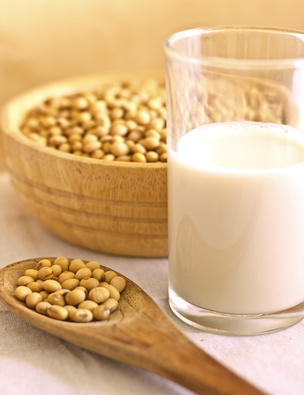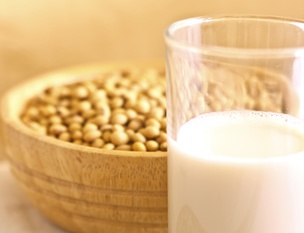What Soy Products Really Do For Your Health
 Surely you’ve heard all good things about soy. The FDA itself reports that soy can help fight cardiovascular problems, make your bone density stronger and can even fight cancer. Recently though, news articles and research journals have been saying otherwise. How do you reconcile the purported health benefits of soy to the claims that it is bad for your body? You’re surely asking yourself: Is soy bad for my body?
Surely you’ve heard all good things about soy. The FDA itself reports that soy can help fight cardiovascular problems, make your bone density stronger and can even fight cancer. Recently though, news articles and research journals have been saying otherwise. How do you reconcile the purported health benefits of soy to the claims that it is bad for your body? You’re surely asking yourself: Is soy bad for my body?
There’s no single answer to this, and I’ll let you in on why soy is bad for your body—and how you can turn it around.
The Soy That’s Bad For Your Body
The answer to whether or not soy is bad for the body must be qualified. In all fairness, not all soy products are dangerous to the body. There are two in particular that give soy a bad name: genetically modified soy and unfermented soy, the latter of the two will be discussed at length later.
Genetically modified soy comprises around 75% to 90% of all soy products found in the market. Genetic modification on soy is done to withstand the herbicides it is subjected to during the farming process, without killing it. However, this process has very serious health implications. One of this is the disruption of hormonal balance, especially among women. The herbicide used on soy contains glyphosate: this interferes with the production of estrogen and is toxic to the placenta.
According to Dr. Carrasco of the Faculty of Medicine at Buenos Aires, GMO soy products poses health risks not only for a carrying mother but also for her unborn children. Among a few effects of consistent consumption of GMO soy products are genetic alterations in the nervous system, death of cells that form the skull, eye defects, abnormal eyes, and undeveloped head size.
The Marketing Myth of Soy Products
Were you there in the 1990s when soy products ecame a huge hit among consumers?? Soy products were then touted as the next health miracle of the generation. Among its promised health benefits were protection against breast and prostate cancer and the ability to lower cholesterol levels. Vegetarians and health buffs quickly jumped at it in blind belief that soy had the ability to deliver all of its promises.
Now it’s becoming clear that not all soy products are as healthy as they promise.
So why were soy products marketed in the early 90’s as a health product? The answer is simple: business. Even the doctors who promoted soy have benefited from recommending soy to their patients. Now, these same promoters like Dr. Christiane Northrup (who is reported to have hypothyroidism) have been diagnosed with the same conditions associated with soy products.
The production of soy has turned into a multibillion dollar empire and various components of unfermented soybeans have found their way into the Standard American Diet. To encourage consumption of soy and to further boost soybean factories, the health myths of soybeans are further propagated as bible truth.
Soybean farming has grown into such a huge industry that The Whole Soy Story, a organization dedicated to enlightening people about the real effects of soy, has reported that it has destroyed more Amazon rainforests than cattle ranching has.
According to Mary Enig, phD, a known nutritionist, the reason why the soy industry became huge started when industrialists and large companies started to venture into soybean farming for soy oil. In no time, there was a lot more soy oil than than the population demanded. In addition, nobody knew what to do with soy protein—an excess residue and by-product that resulted from the production of soy oil. This soy protein as by-product paved the way for companies to invest in different ways to advertise and include soy protein in several food products.
Fermented and unfermented soy: which one is evil?
Not only do you need to make a distinction between organic and genetically modified soy; you also need to know the difference between fermented and unfermented soy. Unfermented soy is found in most processed products, such as soy chips, soy ice creams, soy milk, tofu, soy nuts, and soy formula. If these soy products have somehow found their way in your diet, you might want to regulate them.
One effect of soy is that it speeds up the aging of brain cell, as found in a recent study by Dr. Lon White at the University of Hawaii published in the Journal of the American College of Nutrition last April 2000. According to his study, older people who consumed tofu twice a week consistently for 30 years aged faster than normal. These people looked four years older than their actual age!
Unfermented soy contains phytic acid or phytates, which are nutrient inhibitors. In other words, they block the absorption of minerals found not just in the soy products you’re consuming but also in other foods that you’re eating as well. Some of these minerals are calcium, iron, zinc, and magnesium. When they reach your intestinal tract, these inhibitors prevent your body from absorbing these minerals that would have otherwise helped in nourishing your body! Unfermented soy also contains hemaglutinin and trypsin inhibitors which stunt human growth.
Soy also has a negative effect on the thyroid. As many as 40 milligrams of isoflavones every day can hamper the function of the thyroid hormone, according to Dr. Larrian Gillespie in his books “The Goddess Diet” and “The Menopause Diet”. For reference: a tablespoon of soy powder contains 25 milligrams of isoflavones. Most isoflavone supplements contain 40 milligrams of isoflavones. This means that you can’t take both isoflavone supplements and soy products without putting your health in danger.
Regular consumption of soy among women may result in a feeling of fatigue, constipation, and body ache. Another result is weight gain and heavy menstrual periods. And the worst effect of soy on women? Hypothyroidism.
The ill effects of unfermented soy don’t stop there. As scientists unearth more surprising findings about soy, they’ve also found that unfermented soy is strongly connected to increased cancer risk, reduced male fertility, stunted growth among infants, and early puberty onset.
Unfermented soy perhaps poses the most serious threat to infants who ingest soy formula. According to Prof. Richard Sharpe, an expert of human reproductive sciences, at Medical Research Council in Edinburgh University, there are completed studies linking soy and lower hormone levels.
Thankfully, these effects hold true only for unfermented soy products. On the other side of the coin are fermented soy products. This type is considered beneficial if moderated. A few examples are miso, natto, tempeh, and tamari sauce.
Benefits of Fermented Soy
In unfermented soy, there are several elements and inhibitors that prevent your body from absorbing the nutrients found in soy and in other foods as well. Fermented soy, which has undergone fermentation, essentially removes the trypsin inhibitors, hemagglutinin, and phytates.
The fermentation process manipulates and breaks down the potential poisonous ingredients in unfermented soy and turns them into nutrients that your body can benefit from. In other words, fermented soy have been pre-digested—giving your digestive system a big break from having to take in all the nutrient inhibitors and poisonous content of unfermented soy. When it comes right down to it, fermented soy foods are the only type of soy that the body with all its limitations is capable of digesting and absorbing.
In fact, fermented soy has been a staple food in traditional Asian diets, and has been known to decrease the risk of cardiovascular diseases and cancer, and increase bone density for stronger bones.
One benefit is that it prevents the growth of estrogen-dependent breast cancer cells. A study published in the Cancer Research journal shows that unfermented soy products break down estrogen quickly before cancer cells even grow. In effect, the estrogen molecules broken down find its way in the urine instead of staying in the bloodstream.
Another benefit of fermented soy is that they prevent the growth of prostate cancer cells. The findings in a study published in the International Journal of Oncology report that soy will not only prevent prostate cancer cells but also prevent heart disease, osteoporosis, and endometriosis among women.
But perhaps the most appealing benefit of fermented soy is that it has consistently been proven to lower cholesterol levels. A study published in the American Journal of Clinical Nutrition in December 1998 showed that men with a low-fat diet and who relied on fermented soy as a protein source saw their bad cholesterol levels drop by as much as 14%. Alternatively, their good cholesterol levels increased by as much as 8%.
How to Buy Healthy Soy Products
The simple solution is to stay away from unfermented soy and stick with fermented soy. You will have to be more conscious when picking out products that contain unfermented soy. By default, processed products touting themselves as healthy and packed with nutrients contain unfermented or genetically modified soy ingredients. Stay away from them.
The tricky part is staying away from products that contain unfermented soy but don’t look like it. That’s because unfermented soy hides away from “aliases”, such as “boullion”, “textured plant protein”, and “natural flavor”. Other names for unfermented soy include Lecithin, TVP (textured vegetable protein), soya, yuba, mono-diglyeride, soja, or TSF (textured soy flour).
Make it a habit to carefully read the ingredients when buying products. For all you know, it may contain unfermented soy products!
Also, if you’ve been drinking soy milk as a protein source, you might want to switch to healthier alternatives such as rice milk, hemp milk, and almond milk. That’s because soy milk is not made from fermented soybeans.
Fermented Soy Products To Look Out For
Consuming fermented soy products in moderation is the key to benefiting from the health advantages of fermented soy. Health experts agree that a two-ounce serving of around 2 to 3 times a week is considered a healthy way to include soy in your diet.
A few good sources of fermented soy include soy yogurt, miso, natto, pickled tofu and tempeh. Here’s a lowdown on healthy soy products:
– Tempeh, which can either be baked or grilled, may be combined with pasta sauce. They also go great with vegetables.
– Natto, known for its sweet taste and sticky texture, is usually sliced in small chunks. They go great with broths and soup, and can also serve as a rice topping.
– Miso is one of the more popular healthy soy sources. It has a pasty texture and is usually packaged in a plastic tub. Miso serves as a base for soup and can also work as a broth with noodles and vegetables.
– Pickled tofu, also known as tofu cheese, is not that common and is more likely found in Asian groceries. Pickled tofu is known for the aging process it undergoes and its distinct taste.
Obviously, there’s a lot of misinformation regarding the health benefits of soy. While it’s not totally bad for your body, you might want to reevaluate your entire diet to see if it’s as healthy as you think it is. You may be consuming more soy than you ought to. Worse, you may not realize that you’ve been consuming that much soy in the first place!

Leave a Reply